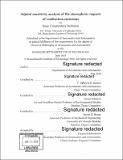Adjoint sensitivity analysis of the atmospheric impacts of combustion emissions
Author(s)
Dedoussi, Irene Constantina
DownloadFull printable version (16.04Mb)
Other Contributors
Massachusetts Institute of Technology. Department of Aeronautics and Astronautics.
Advisor
Steven R.H. Barrett.
Terms of use
Metadata
Show full item recordAbstract
Combustion emissions impact the environment through chemical and transport processes that span varying temporal and spatial scales. Numerical simulation of the effects of combustion emissions and potential corresponding mitigation approaches is computationally expensive. Atmospheric adjoint modeling enables the calculation of receptor-oriented sensitivities of environmental metrics of interest to emissions, overcoming the numerical cost of conventional modeling. This thesis applies and further develops an existing adjoint of a chemistry-transport model to perform three evaluations, where the high number of inputs (due to the nature of the problem or the associated uncertainty) prevented comprehensive assessment in the past. First, this thesis quantifies the pollution exchange between the US states for seven major anthropogenic combustion emissions sectors: electric power generation, industry, commercial/residential, aviation, as well as road, marine, and rail transportation. This thesis presents the state-level fine particulate matter (PM₂.₅) early death impacts of combustion emissions in the US for 2005, 2011 and 2018 (forecast), and how these are driven by sector, chemical species, and location of emission. Results indicate major shifts in the chemical species and sectors that cause most early deaths, and opportunities for further improving air quality in the US. Second, this thesis quantifies how changes in emissions impact the marginal atmospheric PM₂.₅ response to emissions perturbations. State-level annual adjoint sensitivities of PM₂.₅ population exposure to precursor emissions are compared for the years of 2006 and 2011, and correlated with the magnitude of emissions reduction and the background ammonia mixing ratio. Third, this thesis presents the development and evaluation of the discrete adjoint of the GEOS-Chem unified tropospheric-stratospheric chemistry extension (UCX), which enables the calculation of stratospheric sensitivities and the examination of the entire design space of high altitude emissions impacts. To illustrate its potential, sensitivities of stratospheric ozone to precursor species are calculated. This development expands the span of atmospheric chemistry-transport questions (including inversions) that this open-source model can be used to answer. The assessments performed in this thesis span spatial scales from the regional to the global and demonstrate the ability of this approach to provide information on both bottom-up and top-down mitigation approaches.
Description
Thesis: Ph. D., Massachusetts Institute of Technology, Department of Aeronautics and Astronautics, 2018. Cataloged from PDF version of thesis. Includes bibliographical references (pages 127-149).
Date issued
2018Department
Massachusetts Institute of Technology. Department of Aeronautics and AstronauticsPublisher
Massachusetts Institute of Technology
Keywords
Aeronautics and Astronautics.